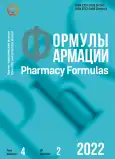Molecular mechanisms of molecular transfer across the blood-brain barrier as a target for pharmacological action. Part 1. Structure, function and pathology of the BBB
- Authors: Trofimov A.N.1,2, Litvinova M.V.1,2, Schwarz A.P.3, Kosheverova V.V.4, Lebedev A.A.2, Arseniev N.A.1, Tyukavin A.I.1
-
Affiliations:
- Saint Petersburg Chemical and Pharmaceutical University of the Ministry of Health of the Russian Federation
- Institute of Experimental Medicine
- I. M. Sechenov Institute of Evolutionary Physiology and Biochemistry of the Russian Academy of Sciences
- Institute of Cytology of the Russian Academy of Sciences
- Issue: Vol 4, No 2 (2022)
- Pages: 60-69
- Section: Actual problems: discussion tribune
- URL: https://journals.rcsi.science/PharmForm/article/view/232618
- DOI: https://doi.org/10.17816/phf109914
- ID: 232618
Cite item
Full Text
Abstract
Biological barriers play a key role in maintaining the integrity and functioning of the body at all levels of its organization. The barrier function at the cellular level is based on the hydrophobic properties of the cytoplasmic membrane, which provide selective permeability for various substances, depending on their chemical properties. At higher levels of organization, from tissue to organism, the barrier function is based on intercellular protein complexes of the plasma membrane, which form paracellular diffusion barriers and separate internal and external fluid media, which is a necessary condition for the development and functioning of each organ. The blood-brain barrier (BBB) plays an important role in maintaining the function of the brain. The review reflects the main stages in the embryonic development of the BBB, as well as presents current data on the morphological and functional features of the organization of the BBB, including molecular mechanisms that mediate the barrier function due to the complex participation of vascular cells of cerebral microvessels, as well as gene expression of enzyme complexes, active and passive substance transport mechanisms through the BBB. The high transport selectivity of the BBB is an urgent problem for the delivery of drugs to the brain. At the same time, it is equally important to improve the principles of pharmacotherapy for the correction of impaired BBB functions in various types of pathology of the nervous and other body systems. This review aims to convey to the developers of modern targeted drugs new information about the molecular genetic mechanisms of the transport of substances through the BBB, as well as to draw the attention of specialists in the field of precision medicine to the problem of violations of the barrier function of cerebral vessels in neurological and other diseases of a modern person.
Full Text
##article.viewOnOriginalSite##About the authors
Alexander N. Trofimov
Saint Petersburg Chemical and Pharmaceutical University of the Ministry of Health of the Russian Federation; Institute of Experimental Medicine
Author for correspondence.
Email: alexander.n.trofimov@gmail.com
ORCID iD: 0000-0001-6745-6035
SPIN-code: 4935-0744
Ph.D. in Biological Sciences, Senior Researcher at the I.P. Pavlov Department of Physiology, Associate Professor at the Department of Physiology and Pathology
Russian Federation, Saint Petersburg; Saint PetersburgMariya V. Litvinova
Saint Petersburg Chemical and Pharmaceutical University of the Ministry of Health of the Russian Federation; Institute of Experimental Medicine
Email: litvinova.mariya@pharminnotech.com
ORCID iD: 0000-0002-2924-7475
Postgraduate Student at the S. V. Anichkov Department of Neuropharmacology; Laboratory Assistant at the Department of Physiology and Pathology
Russian Federation, Saint Petersburg; Saint PetersburgAlexander P. Schwarz
I. M. Sechenov Institute of Evolutionary Physiology and Biochemistry of the Russian Academy of Sciences
Email: aleksandr.pavlovich.schwarz@gmail.com
ORCID iD: 0000-0003-2707-1397
SPIN-code: 5017-0779
Ph.D. in Biological Sciences, Researcher at the Laboratory of Molecular Mechanisms of Neural Interactions
Russian Federation, Saint PetersburgVera V. Kosheverova
Institute of Cytology of the Russian Academy of Sciences
Email: vera77867@mail.ru
ORCID iD: 0000-0002-9221-9362
SPIN-code: 4821-9340
Ph.D. in Biological Sciences, Researcher at the Laboratory of Intracellular Membrane Dynamics
Russian Federation, Saint PetersburgAndrei A. Lebedev
Institute of Experimental Medicine
Email: aalebedev-iem@rambler.ru
ORCID iD: 0000-0003-0297-0425
SPIN-code: 4998-5204
Doctor of Biological Sciences, Professor, Head of the Laboratory of General Pharmacology, S. V. Anichkov Department of Neuropharmacology
Russian Federation, Saint PetersburgNikolai A. Arseniev
Saint Petersburg Chemical and Pharmaceutical University of the Ministry of Health of the Russian Federation
Email: nikolay.arseniev@pharminnotech.com
SPIN-code: 9038-7623
Ph.D. in Biological Sciences, Associate Professor at the Department of Physiology and Pathology
Russian Federation, Saint PetersburgAlexander I. Tyukavin
Saint Petersburg Chemical and Pharmaceutical University of the Ministry of Health of the Russian Federation
Email: atuykavin@mail.ru
ORCID iD: 0000-0001-5129-4414
SPIN-code: 8476-5366
Scopus Author ID: 6603645369
ResearcherId: V-6699-2017
Doctor of Medical Sciences, Professor, Head of the Department of Physiology and Pathology
Russian Federation, Saint PetersburgReferences
- Maryanovich A. T, Andreevskaya M. V. Blood-brain barrier: protective function. Russian biomedical research. 2020;5(2):42-48. (In Russ.).
- Wardlaw J., Duplaà C., Dabertrand F., et al. Vascular hypotheses for understanding and restoring memory impairments. FENS Forum; July 2022; France; Paris.
- Neuwelt E. A. Mechanisms of disease: the blood-brain barrier. Neurosurgery. 2004;54(1):131-142. https://doi.org/10.1227/01.neu.0000097715.11966.8e.
- Kugler E. C., Greenwood J., MacDonald R. B. The "Neuro-Glial-Vascular" Unit: The Role of Glia in Neurovascular Unit Formation and Dysfunction. Front Cell Dev Biol. 2021;9:732820. https://doi.org/10.3389/fcell.2021.732820.
- Liebner S., Dijkhuizen R. M., Reiss Y., et al. Functional morphology of the blood-brain barrier in health and disease. Acta Neuropathol. 2018;135(3):311-336. https://doi.org/10.1007/s00401-018-1815-1.
- Ahn S. I., Kim Y. Human Blood-Brain Barrier on a Chip: Featuring Unique Multicellular Cooperation in Pathophysiology. Trends Biotechnol. 2021;39(8):749-752. https://doi.org/10.1016/j.tibtech.2021.01.010.
- Yuan M., Wang Y., Wang S., et al. Bioenergetic Impairment in the Neuro-Glia-Vascular Unit: An Emerging Physiopathology during Aging. Aging Dis. 2021;12(8):2080-2095. https://doi.org/10.14336/AD.2021.04017.
- Neumaier F., Zlatopolskiy B. D., Neumaier B. Drug Penetration into the Central Nervous System: Pharmacokinetic Concepts and In Vitro Model Systems. Pharmaceutics. 2021;13(10):1542. https://doi.org/10.3390/pharmaceutics13101542.
- Menaceur C., Gosselet F., Fenart L., et al. The Blood-Brain Barrier, an Evolving Concept Based on Technological Advances and Cell-Cell Communications. Cells. 2021;11(1):133. https://doi.org/10.3390/cells11010133.
- Ayloo S., Gu C. Transcytosis at the blood-brain barrier. Curr Opin Neurobiol. 2019;57:32-38. https://doi.org/10.1016/j.conb.2018.12.014.
- de Lange E. C. M, Hammarlund Udenaes M. Understanding the Blood-Brain Barrier and Beyond: Challenges and Opportunities for Novel CNS Therapeutics. Clin Pharmacol Ther. 2022;111(4):758-773. https://doi.org/10.1002/cpt.2545.
- Abbott N. J., Patabendige A. A., Dolman D. E., et al. Structure and function of the blood-brain barrier. Neurobiol Dis. 2010;37(1):13-25. https://doi.org/10.1016/j.nbd.2009.07.030.
Supplementary files










